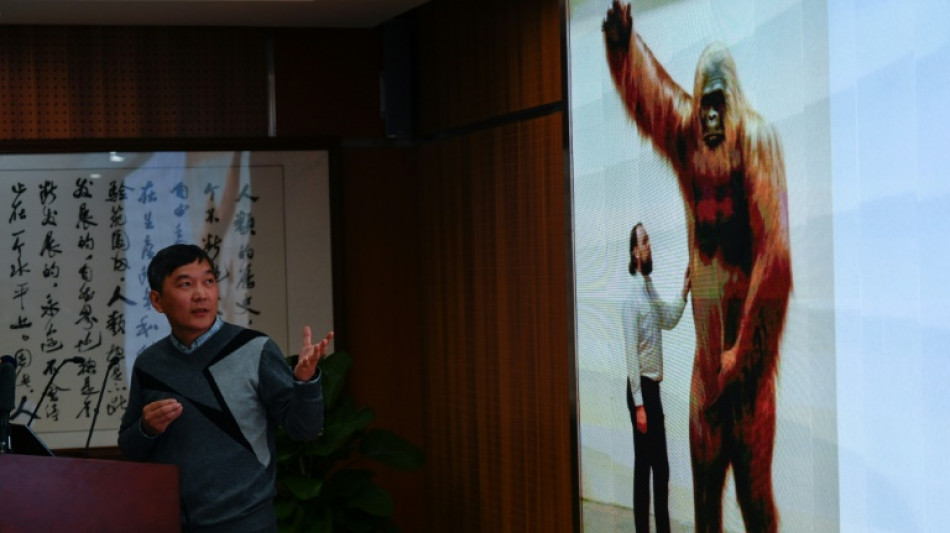
-
 Striking Boeing defense workers to vote on latest contract
Striking Boeing defense workers to vote on latest contract
-
Australia's opposition ditches commitment to net zero emissions

-
 Duffy takes four as New Zealand crush West Indies to seal T20 series
Duffy takes four as New Zealand crush West Indies to seal T20 series
-
South Korea halts flights for college entry exam

-
 Trump signs bill to end record-breaking US shutdown
Trump signs bill to end record-breaking US shutdown
-
EU lawmakers to vote on unpicking green business rules

-
 Smith says England speed kings could struggle in Ashes
Smith says England speed kings could struggle in Ashes
-
Stocks stutter with focus on Fed, tech after US reopen vote

-
 Record-breaking US shutdown ends as political fallout begins
Record-breaking US shutdown ends as political fallout begins
-
France marks decade since harrowing Paris attacks

-
 Skubal, Skenes win MLB Cy Young Awards for top pitchers
Skubal, Skenes win MLB Cy Young Awards for top pitchers
-
Record rains turn Argentina's farm-filled Pampas plains to wetlands

-
 Solar storm brings new chance of vivid auroras, signal disruptions
Solar storm brings new chance of vivid auroras, signal disruptions
-
Gauff and Fritz back for United Cup against Swiatek's Poland

-
 World's fossil fuel emissions to hit new record in 2025: study
World's fossil fuel emissions to hit new record in 2025: study
-
US jury: Boeing owes $28 mn to family of Ethiopian Airlines crash victim

-
 G7 calls for urgent Ukraine ceasefire, de-escalation in Sudan
G7 calls for urgent Ukraine ceasefire, de-escalation in Sudan
-
Bayern stun Arsenal, Man Utd sink PSG in Women's Champions League

-
 New Epstein emails claim Trump 'knew about the girls'
New Epstein emails claim Trump 'knew about the girls'
-
Brazil tribal chief ready to give Lula a 'talking-to'

-
 Clippers' Beal to have season-ending surgery - report
Clippers' Beal to have season-ending surgery - report
-
Dow ends at record on hopes US government will reopen

-
 Portugal's Ronaldo hoping Ireland fans boo him
Portugal's Ronaldo hoping Ireland fans boo him
-
England set for Etihad start to Euro 2028 tournament campaign

-
 Sinner cruises past Zverev and into last four of ATP Finals
Sinner cruises past Zverev and into last four of ATP Finals
-
US presses final penny after more than 230 years

-
 Baxter says England must be 'selfless' to see off All Blacks
Baxter says England must be 'selfless' to see off All Blacks
-
Pardoned French-Algerian writer Sansal arrives in Germany

-
 Bayern battle back to shock Arsenal in Women's Champions League
Bayern battle back to shock Arsenal in Women's Champions League
-
China hopes US will 'some day' return to climate fold, official tells AFP

-
 Trump 'knew about the girls,' new Epstein emails claim
Trump 'knew about the girls,' new Epstein emails claim
-
Scotland 'optimistic' Russell will be fit to face Argentina

-
 Big platforms chart gradual path to self-driving at Web Summit
Big platforms chart gradual path to self-driving at Web Summit
-
Jane Goodall honored in Washington by conservationists including DiCaprio

-
 Tuberculosis killed 1.23 million last year: WHO
Tuberculosis killed 1.23 million last year: WHO
-
New Zealand coach Robertson says Twickenham visit is 'why I'm doing the job'

-
 Hopes of US shutdown deal fail to sustain market rally
Hopes of US shutdown deal fail to sustain market rally
-
US military personnel do not risk prosecution for drug strikes: Justice Dept

-
 Jailed writer Sansal on way to Germany after Algeria pardon
Jailed writer Sansal on way to Germany after Algeria pardon
-
Ukraine ministers resign over major corruption scandals

-
 Record-breaking US shutdown to end as political fallout begins
Record-breaking US shutdown to end as political fallout begins
-
Wallets, not warming, make voters care about climate: California governor

-
 Astronomers spot storm on another star for first time
Astronomers spot storm on another star for first time
-
G7 foreign ministers seek to boost Ukraine war effort

-
 Released Epstein emails allege Trump 'knew about the girls'
Released Epstein emails allege Trump 'knew about the girls'
-
Rees-Zammit back in Wales 'happy place' after Test return

-
 Chelsea winger Sterling's house burgled
Chelsea winger Sterling's house burgled
-
Auger-Aliassime beats Shelton to get off mark at ATP Finals

-
 Argentina's Milei to follow Trump in skipping S.Africa G20: spokesperson
Argentina's Milei to follow Trump in skipping S.Africa G20: spokesperson
-
Back on track: Belgian-Dutch firm rescues Berlin to Paris sleeper train


Late apes: Biggest primate ever died off due to 'huge mistake'
The largest primate ever to walk the Earth went extinct because it could not adapt to its changing environment, with the mighty beast reduced to living off bark and twigs before dying off, scientists said on Wednesday.
Gigantopithecus blacki, which stood three metres tall (10 feet) and weighed up to 300 kilogrammes (660 pounds), thrived in the forests of southern Asia until a little more than 200,000 years ago.
Exactly why the great ape died off after flourishing for hundreds of thousands of years has been one of the lasting mysteries of palaeontology ever since a German scientist first stumbled on one of its teeth at a Hong Kong apothecary in the 1930s.
The molar was so massive it was being sold as a "dragon's tooth".
"It was three to four times bigger than the teeth from any great ape," Renaud Joannes-Boyau, a researcher at Australia's Southern Cross University, told AFP.
"That intrigued him and that's where all this research started," said Joannes-Boyau, a co-author of a new study in the journal Nature.
All that has been found of the Gigantopithecus since are four partial jawbones and around 2,000 teeth, hundreds of which were discovered inside caves in southern China's Guangxi province.
Even after a decade of excavations in these caves, the cause of the ape's extinction remained elusive, said the study's co-lead author Yingqi Zhang of China's Institute of Vertebrate Palaeontology and Palaeoanthropology.
- Huge apes can't jump -
Seeking to establish a timeline of the animal's existence, the team of Chinese, Australian and US scientists collected fossilised teeth from 22 caves.
The team used six different techniques to determine the age of the fossils, including a relatively new method called luminescence dating which measures the last time minerals were exposed to sunlight.
The oldest teeth dated back more than two million years, while the most recent were from around 250,000 ago.
Now the researchers can tell "the complete story about Gigantopithecus's extinction" for the first time, Zhang told AFP in his office in Beijing.
They established that the animal's "extinction window" was between 215,000 and 295,000 years ago, significantly earlier than previously thought.
During this time, the seasons were becoming more pronounced, which was changing the local environment.
The thick, lush forest that Gigantopithecus had thrived in was starting to give way to more open forests and grassland.
This increasingly deprived the ape of its favourite food: fruit.
The huge animal was bound to the ground, unable swing into the trees for higher food.
Instead, it "relied on less nutritious fall-back food such as bark and twigs," said Kira Westaway, a geochronologist at Australia's Macquarie University and co-lead author.
Zhang said this was a "huge mistake" which ultimately led to the animal's extinction.
- Clever relative -
The primate's size made it difficult to go very far to search for food -- and its massive bulk meant that it needed plenty to eat.
Despite these challenges, "surprisingly G. blacki even increased in size during this time," Westaway said.
By analysing its teeth, the researchers were able to measure the increasing stress the ape was under as its numbers shrunk.
They also compared Gigantopithecus' fate to its orangutan relative, Pongo weidenreichi, which handled the changing environment far better.
The orangutan was smaller and more agile, able to move swiftly through the forest canopy to gather a variety of food such as leaves, flowers, nuts, seeds, and even insects and small mammals.
It became even smaller over time, thriving as its massive cousin Gigantopithecus starved.
Westaway emphasised that it was important to understand the fate of the species that came before us -- particularly "with the threat of a sixth mass extinction event looming over us".
B.Finley--AMWN


